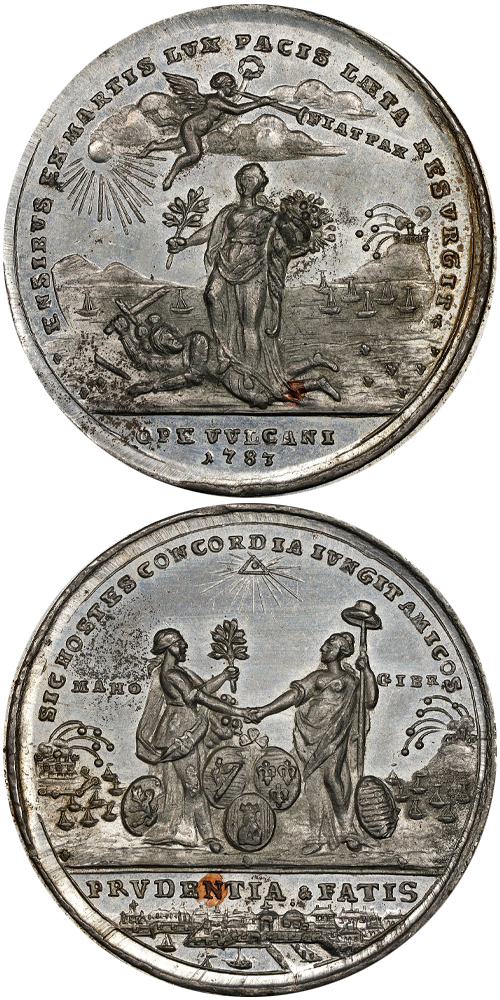Betts-610
1783 Treaty of Paris Medal
Catalog Reference
A.J.N., II, 65; XXIII, 33
V.L. Sup. 592
One of the most famous medals celebrating the Treaty of Paris, signed by representatives of Great Britain's King George III and the United States on September 3, 1783 to end the American Revolutionary War. The Dutch government presented a tin impression to John Adams in 1787, which later found its way into the Massachusetts Historical Society collection.
This design is indeed a bit busy and full of interesting allegories, making it a particularly interesting one to examine at length. The obverse shows two standing figures. The right figure holds an olive branch and is surrounded by the shields of the Netherlands, Great Britain (represented by the harp of Ireland, oddly), Spain, and France. The left figure holds a pole topped by a pileus or liberty cap and has the American shield of 13 horizontal bars at her feet. Betts interprets the right figure to represent peace, but it may just as well symbolize all Europe which has come to peace with the new nation America. At left and right, towns bombard approaching vessels; these represent Port Mahon in the Balearic Islands off Spain and Gibraltar with appropriate abbreviations (MAHO and GIBR) at each. Above an image of the all-seeing eye the legend reads SIC HOSTES CONCORDIA JUNGIT AMICOS or "thus concord unites enemies as friends." The exergue shows a detailed city scene "intended for Paris, where the treaty was signed," according to Betts, with an exergual legend PRUDENTIA & FATIS or "prudence and fate."
The reverse shows Peace, who holds her olive branch and cornucopia, standing over Mars or War with more flying bombs and passive ships in the background. The legend ENSIBUS EX MARTIS LUX PACIS LAETA RESURGIT or "from the swords of Mars, the joyful light of peace rises again" refers to this scene; the legend continues OPE VULCANI or "by the aid of Vulcan," the god of industry, in the exergue with the date 1783. A cherub holds a laurel and trumpet which announces FIAT PAX or "let there be peace." Brown and Forrer both attribute authorship of this medal to Johann Christian Reich, father of Johann Matthaus Reich, or John Reich, the future engraver at the United States Mint.
With its remarkable variety of allegories and celebratory legends relating to the Treaty of Paris, in addition to its superlative condition and well-known engraver, this medal is sure to be of great interest.






